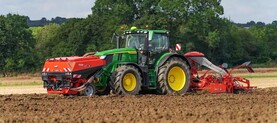Youth, enthusiasm, and a good dose of fearless change might well be the ingredients the tillage sector needs right now. All three were clearly evident in a presentation that Castlemagner’s Rob Coleman delivered at the Dairygold tillage conference in Cork last week.
The sector is under big pressure. Land is under increasing demand and costing more and more. Margins are tight as costs are astronomical.
According to Teagasc specialist Ciaran Collins, production costs for a three tonne per acre barley crop have more than doubled to €212/tonne in the past 15 years. A tonne of barley would have bought 50 barrels of oil in 1973, but today it buys you four barrels.
Our Government wants more tillage but, like forestry and organics, unless something changes, the stretch targets seem doomed for failure. Yes, we might have more organic farmers and area, but all indications are there won’t be much additional organic produce.
So where now for tillage? Bank of Ireland’s Eoin Lowry said the Irish livestock industry needs an Irish tillage sector – does it really? We grow an abundance of protein in Irish fields.
South America looks set to grow grain for China and further afield. Our leading dairy researchers still say that costly inputs are not the way to drive higher milk output.
The “less is more” mantra holds firm, even in the face of a derogation reducing from 250kg N/ha to 220kg N/ha according to the best scientists.
Volatile
Our milk processors suggest they can’t smooth the volatile price waves for suppliers, so the onus is on suppliers to smooth out the hollows for themselves.
Growing more grass, reducing stocking rate and reducing nitrogen inputs seem to be the order of the day. So, does the Irish livestock industry really need a tillage sector?
The average dairy cow in the south is eating over 1,000kg per year. It’s over twice this in Northern Ireland. The average finished bullock is eating over a tonne of feed in its lifetime.
Straw for bedding is at a premium right now. So while it’s a relatively small part of the system, yes, it’s a vital piece of the jigsaw. However, where does ‘Irish’ grain fit? Do livestock farmers value it enough?
If I ask tillage farmers, they feel largely unloved by the industry, in that the premium paid over and above global product is small or maybe even sometimes discounted.
Getting back to Coleman and what the tillage sector can do for itself. Coleman provided a tour de force in soil management that delivers on his Cork farm.
Rotation, minimal cultivation when it suits, minimal inputs where possible, and mixing in cattle to create high value organic matter are part of the story.
He didn’t claim to know it all or advise anyone on what to do, and he attributed much of his learnings to his father.
However, it is clear he recognises the challenge the industry is facing, and maybe that’s why his story resonated. He upskilled to recognise degradation of soil quality.
He recognised that new ideas and innovations are needed. Speaking to the 300 strong group of farmers, Coleman’s speech served as a wake-up call.
A tillage revolution is needed on some farms to put life back into the soil.
Holistic
The malting barley award might well recognise where the good dry soils and top class management are right now, however, a more holistic award that recognises soil health, soil life, and lower energy usage looks like the tillage farm of the future.
A bit like the dairy sector, a low herd somatic cell count is excellent, but if it’s taking a bucket of antibiotics, a 30% cull rate and 24 hour care to deliver that result, then it might not represent the dairy farmers of the future.
Coleman’s keywords were dig, talk, listen and learn; profit is the core principle. While all tillage farmers might not be adding molasses to foliar nitrogen this year, Coleman’s principle of do a small bit and learn from it is good advice for young, aspiring tillage farmers.






 This is a subscriber-only article
This is a subscriber-only article










SHARING OPTIONS: